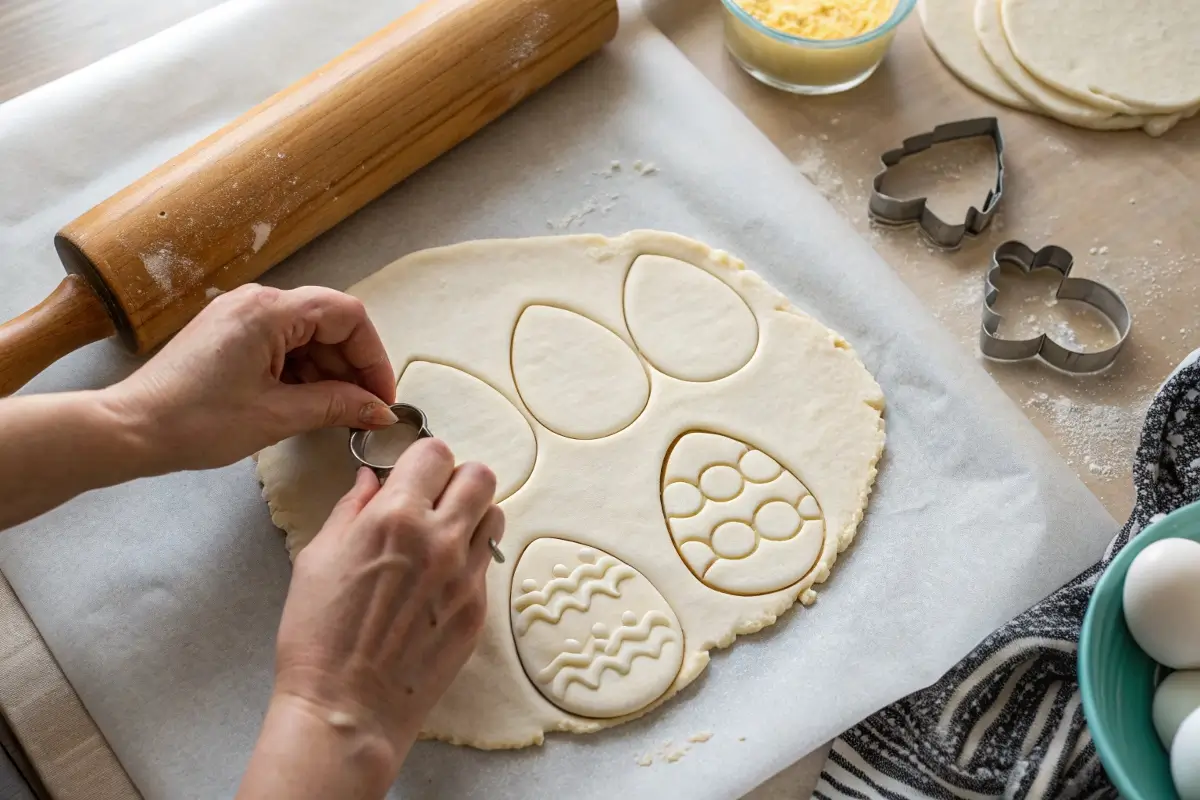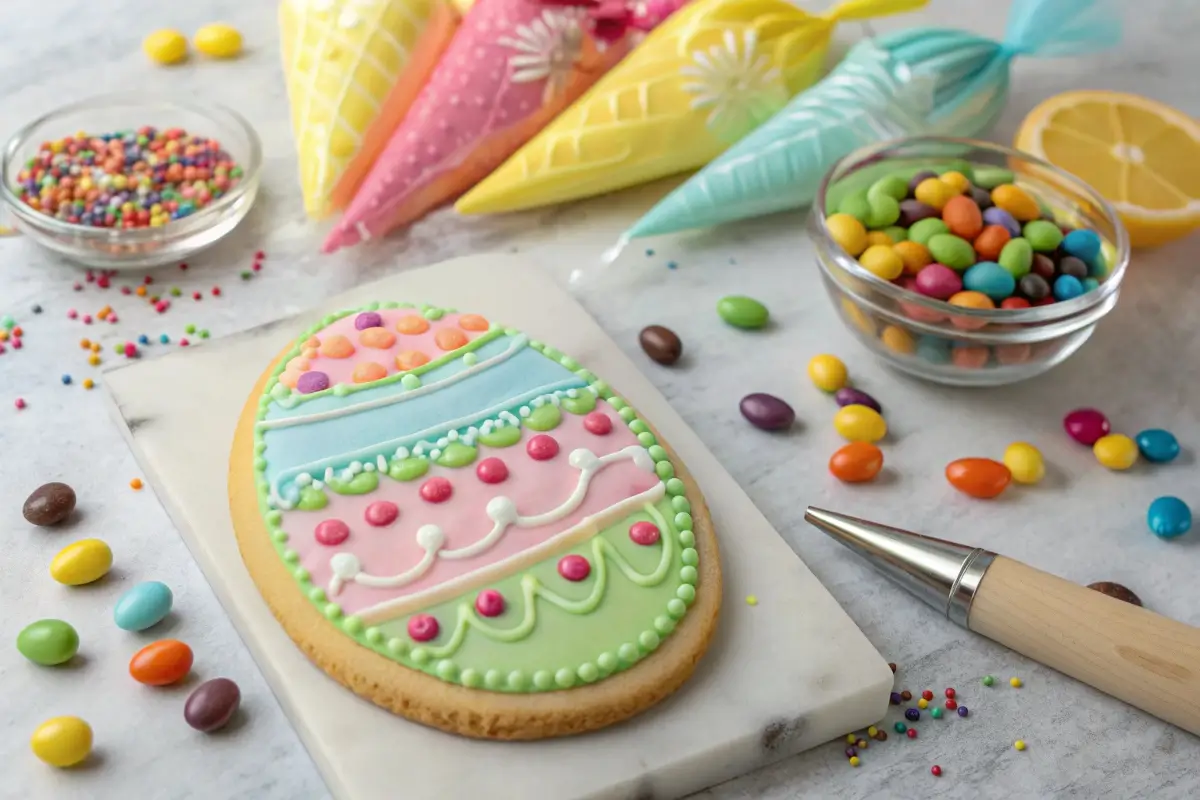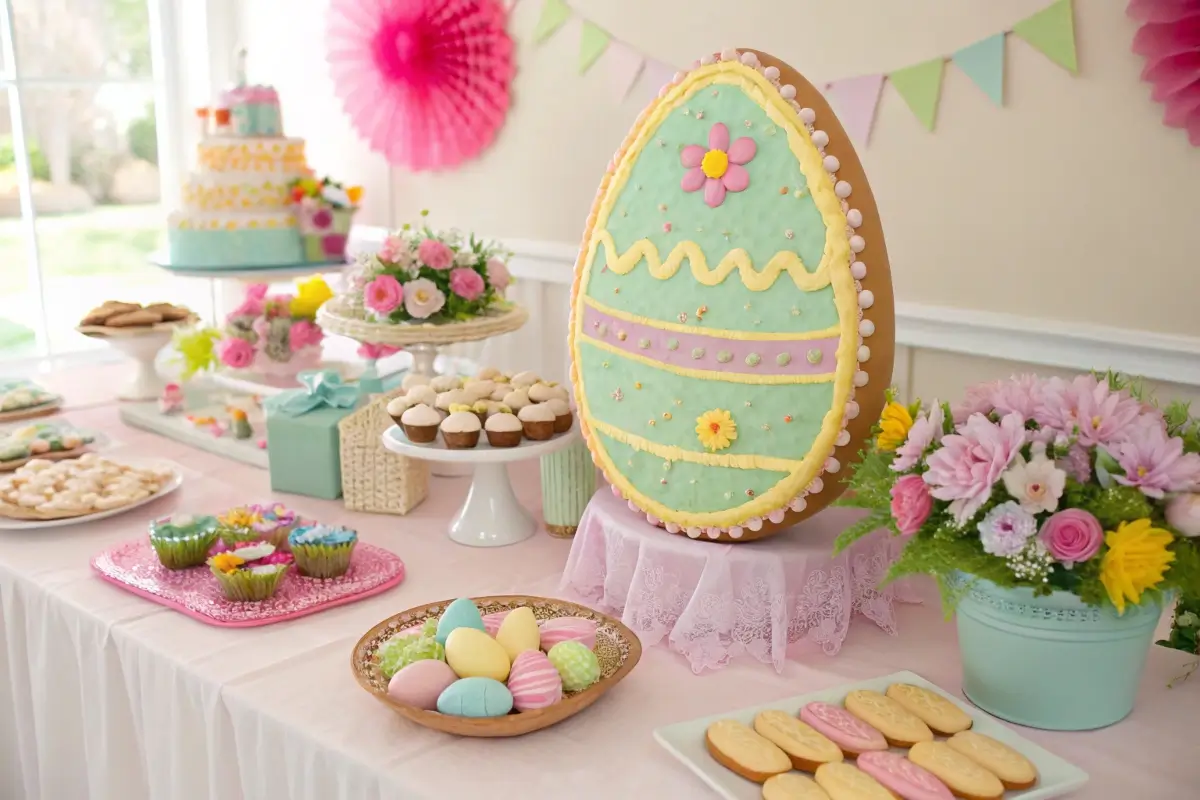Introduction to Easter Egg Cookie Cake
Easter is that magical time of year when family, faith, and food come together to create cherished memories. Whether you’re planning a spring brunch, an egg hunt party, or a cozy Sunday dinner, your dessert table deserves something extra special. That’s where the Easter egg cookie cake comes in.
Check out The Ultimate Guide to Chocolate Easter Cup Cakes Everyone Will Love for more springtime baking inspiration.
Growing up, Easter Sunday always meant one thing: a table full of sweets and a kitchen full of laughter. But one year stands out more than the rest. I must have been about eight years old, wearing pastel bunny ears and sticky with frosting. My grandma laid out a giant cookie in the shape of an Easter egg and handed me a piping bag for the first time.
At first, I didn’t know what I was doing—I made squiggly lines, uneven dots, and somehow ended up with more frosting on my hands than the cookie. But she just smiled and said, “Perfect. That’s how Easter is supposed to be.” We decorated it together, side by side, turning that cookie into our very own masterpiece.
That moment stuck with me. It wasn’t just about baking—it was about bonding, giggling over too many jellybeans, and creating something sweet from scratch. Now, every time I make an Easter egg cookie cake, I think of that day and how a simple dessert became a forever memory.
Table of Contents
Introduction to Easter Egg Cookie Cake
What is an Easter egg cookie cake?
An Easter egg cookie cake is exactly what it sounds like—a giant cookie baked in the shape of an Easter egg, then decorated with frosting, pastel colors, and your favorite Easter candies. Think of it as the best parts of a sugar cookie and a cake rolled into one festive masterpiece. It’s large enough to slice and serve like a cake but made with cookie dough instead of batter.
Unlike traditional cakes, cookie cakes don’t require complicated layers, fillings, or frosting techniques. The texture is denser, often with a slightly crisp edge and a chewy, gooey center—exactly what you’d expect from a well-baked cookie.
This dessert has become increasingly popular in Easter baking because it’s simple, delicious, and eye-catching. Whether you’re going for a rustic homemade look or a Pinterest-worthy showstopper, this cake checks all the boxes.
Ingredients You’ll Need for the Perfect Easter Egg Cookie Cake
Creating an Easter egg cookie cake from scratch doesn’t require a pantry full of fancy ingredients. In fact, most of the items are already kitchen staples. But it’s the little festive additions—like candy eggs and colorful sprinkles—that turn an ordinary cookie into a holiday showpiece.
Must-have pantry ingredients for the cookie base
The base of your cookie cake can vary depending on your favorite cookie flavor. However, the most classic version uses a buttery sugar cookie or chocolate chip cookie dough. Here’s what you’ll typically need:
| Ingredient | Purpose |
|---|---|
| All-purpose flour | The foundation of your dough |
| Baking soda & salt | Helps with rise and balance of flavor |
| Unsalted butter | Adds richness and flavor |
| Brown sugar & granulated sugar | Provides sweetness and moisture |
| Large eggs | Binds ingredients and adds structure |
| Vanilla extract | Enhances the flavor profile |
| Chocolate chips (optional) | Adds bursts of sweetness throughout the cookie |
For those who prefer a gluten-free or vegan option, you can easily swap ingredients. Use almond or oat flour, vegan butter, and flax eggs to match dietary needs. These versions hold up well and still give you that chewy texture that makes cookie cakes so crave-worthy.
Topping essentials: Easter candy, frosting, and more
This is where you get to have some fun. Decorating your Easter egg cookie cake is all about color, creativity, and texture.
Here are some must-have toppings to keep on hand:
- Pastel-colored buttercream frosting – Use piping bags with different tips for swirls, borders, and lettering
- Mini chocolate eggs – Adds a 3D pop and enhances the Easter theme
- Sprinkles and nonpareils – For a playful finish
- Shredded coconut (dyed green) – Great for creating grass textures
- Marshmallow chicks or bunnies – Cute, edible decorations
- Candy-coated chocolates – Think mini M&Ms or pastel Reese’s pieces
Pro Tip: Separate your candy toppings by color in small bowls to easily create patterns or stripes on your cookie cake.
When you’re preparing your decorations, make sure your cookie cake has fully cooled before you add frosting or candies. That way, nothing melts or slides off.
Don’t miss our Street Corn Chicken Rice Bowl Recipe – A Flavorful Fusion Dish if you want a savory dish to pair with your Easter dessert spread.
How to Make an Easter Egg Cookie Cake from Scratch
So, you’ve gathered your ingredients and you’re ready to bake something fun, festive, and crowd-pleasing. Making an Easter egg cookie cake is easier than it looks and perfect for both beginners and seasoned bakers. This step-by-step guide will walk you through the entire process.

Step-by-step cookie cake base recipe
Start by preheating your oven to 350°F (175°C) and prepping your baking surface.
1. Prepare your baking pan
Use a round pizza pan, a rimmed baking sheet, or a cookie cake-specific pan. Line it with parchment paper or lightly grease it. To create an egg shape, you can draw an egg outline on the back of parchment and use it as a guide.
2. Make your cookie dough
In a large mixing bowl:
- Cream together 1 cup (2 sticks) of unsalted butter, ¾ cup brown sugar, and ½ cup white sugar until light and fluffy.
- Add 2 large eggs and 2 teaspoons of vanilla extract. Mix until well combined.
- In a separate bowl, whisk 2 ½ cups of all-purpose flour, 1 teaspoon baking soda, and ½ teaspoon salt.
- Gradually mix the dry ingredients into the wet ingredients.
- Fold in 1 to 1½ cups of chocolate chips (or your mix-ins of choice).
3. Shape the cookie
Press the dough into your prepared pan, smoothing it into an egg shape. You can also cut the shape after baking if you’re using a rectangular sheet pan—just be sure to shape it before decorating.
4. Bake to perfection
Place the pan in the oven and bake for 20–25 minutes, or until the edges are golden and the center is just set. Don’t overbake—it will continue to cook as it cools.
5. Cool before decorating
Let the cookie cake cool completely in the pan. Transfer it carefully to a serving board or cake stand.
Tips for shaping the cookie like an Easter egg
Creating the iconic egg shape can be done in two ways:
Option 1: Shape before baking
Use a knife or your hands to mold the raw dough into an oval, slightly pointy at one end. Draw an outline on parchment paper to guide your shaping.
Option 2: Cut after baking
Bake the dough as a rectangle, then use a cardboard template or freehand a cut with a sharp knife once it cools. Save the offcuts for snacking!
Want a cookie cake that holds its shape better? Chill your shaped dough in the refrigerator for 15–20 minutes before baking. It helps reduce spreading.
Discover great ideas like Homemade Vanilla Nut Granola: Crunchy & Healthy Breakfast Recipe to pair with your Easter brunch lineup.
Decorating Ideas for Easter Egg Cookie Cake
Once your Easter egg cookie cake is baked and cooled, it’s time to turn it into a work of edible art. Whether you’re aiming for a Pinterest-worthy masterpiece or letting the kids go wild with frosting, there’s no wrong way to decorate this festive treat.

Frosting styles and Easter color themes
Frosting is your foundation for decorating. You can go bold or subtle depending on the vibe you’re aiming for. We recommend using a buttercream or cream cheese frosting for maximum flavor and spreadability.
Here’s how to get started:
Choose your color palette
Go with Easter-inspired pastels—think soft pinks, baby blues, lavender, mint green, and buttery yellow. Gel food coloring works best because it gives vibrant hues without thinning your frosting.
Use a piping bag
Load your frosting into piping bags with various tips to create textures like rosettes, stripes, waves, or polka dots. If you don’t have piping tips, use a ziplock bag and snip the corner for a simple DIY solution.
Frosting ideas to try:
- Zig-zag lines across the cake to mimic Easter egg patterns
- Rosette borders around the edge
- Color-blocking sections with different shades
- Grass effect using a grass piping tip and green frosting
Need a visual boost for your brunch table? Looking for inspiration? Try The Ultimate Cowboy Cookie Crumbl Recipe – A Must Try Treat for Cookie Lovers to see how creative cookies can truly shine.
Candy toppings and creative designs
Once your frosting base is down, it’s time to add dimension and fun with toppings. This is where your cookie cake truly becomes a showstopper.
Baking Tips to Get the Perfect Texture
The texture of your Easter egg cookie cake can make or break the whole dessert. You want that golden edge, chewy center, and just the right amount of softness to keep everyone coming back for seconds. Here’s how to bake it like a pro.
How to avoid overbaking your cookie cake
Overbaking is one of the most common mistakes when making cookie cakes. Since the dough is spread thinner than traditional cookies and baked as one large piece, it’s easy to go from golden to dry in a few extra minutes.
Here’s how to get it just right:
- Watch the edges, not just the center
The edges should be a light golden brown while the center might still look slightly underbaked. That’s your cue to pull it out. It will continue cooking from residual heat as it cools. - Use an oven thermometer
Oven temps can vary. Even a 10-degree difference can affect baking. For precise results, use an oven thermometer to make sure you’re baking at 350°F exactly. - Check at the 18-minute mark
Start checking early to avoid overbaking. Every oven is different, so don’t rely solely on time—trust your eyes. - Rotate your pan halfway through
If your oven has hot spots, rotating your pan ensures even baking and prevents one side from overbaking.
Getting that chewy center and crispy edge
Everyone loves a cookie cake with a chewy center and slightly crisp edge. It’s the ultimate texture combo—and totally doable at home.
Here’s how to achieve it:
Use a mix of sugars
Combining brown sugar and white sugar is key. Brown sugar adds moisture and chewiness, while white sugar helps with structure and those crisp edges.
Don’t skip the chilling step
If you want extra chewiness, chill your dough for 15 to 30 minutes before baking. It gives the flour time to hydrate and enhances the final texture.
Avoid overmixing
Once you add the flour, mix only until combined. Overmixing creates a dense, tough cookie cake.
Add mix-ins strategically
Fold chocolate chips, candy pieces, or crushed cookies into the dough just before spreading it into the pan. Overmixing them can break them down and alter your texture.
Cool on the pan
Let your cookie cake cool completely in the pan before transferring. Moving it too early can cause it to crack or fall apart.
Don’t miss our Chicken Rosemary Lasagna: The Ultimate Comfort Food Recipe if you’re building a complete holiday menu with both savory and sweet options.
Easter Egg Cookie Cake Variations You’ll Love
One of the best things about an Easter egg cookie cake is how easy it is to adapt. Whether you’re baking for guests with allergies, avoiding animal products, or just craving something different, you can still make a stunning cookie cake that fits your needs.

Gluten-free and vegan alternatives
Dietary restrictions don’t mean you have to miss out on the fun. With just a few smart swaps, your cookie cake will still be chewy, delicious, and beautifully decorated.
Gluten-Free Version
Replace the all-purpose flour with a 1:1 gluten-free baking flour blend. Many blends already include xanthan gum, which helps replicate the texture of wheat flour.
Other gluten-free tips:
- Use certified gluten-free vanilla extract and baking soda.
- Stick with gluten-free toppings like jelly beans, fruit-flavored candies, or coconut shreds.
Vegan Cookie Cake
To go fully plant-based:
- Swap butter with vegan butter or coconut oil.
- Replace eggs with flax eggs (1 tbsp ground flax + 3 tbsp water per egg).
- Use dairy-free chocolate chips and check that candies like marshmallows are gelatin-free.
- Choose a vegan buttercream frosting or whip up a cashew-based version for a creamy twist.
The result? A cookie cake that looks just as stunning and tastes just as rich—without the animal products.
Storing and Serving Your Easter Egg Cookie Cake
After you’ve wowed your guests with a beautifully decorated Easter egg cookie cake, chances are you’ll have a few slices left—especially if you’ve made multiple desserts. Whether you’re planning ahead or saving leftovers, here’s how to store and serve your cookie cake the right way.
How to store leftovers and keep them fresh
Cookie cakes store surprisingly well, maintaining their chewy texture for several days if handled properly. Here’s how to do it:
Room Temperature Storage
- If your cookie cake is unfrosted, you can cover it tightly with plastic wrap or store it in an airtight container. It will stay fresh at room temperature for up to 3 days.
- If it’s frosted, store it in a covered cake carrier or wrap loosely with foil so the frosting doesn’t smudge.
Refrigeration
For longer freshness (up to 5 days), place the cookie cake in the refrigerator. Make sure it’s well-sealed to avoid drying out. Let it sit at room temp for 30 minutes before serving to regain softness.
Freezing
Yes, you can freeze your Easter egg cookie cake—frosted or unfrosted.
- For best results, slice the cake first, then wrap each piece in parchment paper and place them in a zip-top freezer bag or airtight container.
- It will last in the freezer for up to 2 months.
- Thaw slices at room temperature or warm them in the microwave for 10–15 seconds.
FAQs – Easter Egg Cookie Cake
What is the difference between a cookie and a cookie cake?
The main difference lies in size, texture, and presentation. A cookie is typically small, individual, and round, while a cookie cake is a single large cookie baked in a pan and cut into slices like a cake. Cookie cakes often have a soft, chewy center with crispy edges and are decorated with frosting and toppings, making them perfect for celebrations.
What is a good cake to make for Easter?
A good cake for Easter should be colorful, seasonal, and easy to share. Some popular choices include carrot cake, lemon pound cake, chocolate nest cakes, and the Easter egg cookie cake. This cookie cake stands out because it’s both fun to decorate and super kid-friendly—ideal for holiday gatherings and egg hunt parties.
How to cut an Easter egg shaped cake?
To cut an egg-shaped cookie cake cleanly:
- Let it cool completely to firm up.
- Use a sharp serrated knife and wipe it clean between slices.
- Slice from the center outward, as you would a round cake, or cut into wedge-shaped slices.
For parties, you can also pre-mark slices lightly with a knife before serving.
Conclusion: Make This Easter Extra Sweet with a Cookie Cake Twist
If you’re looking for a dessert that’s eye-catching, crowd-pleasing, and incredibly fun to make, the Easter egg cookie cake is it. From chewy cookie bases to endless decorating possibilities, this dessert adds charm and creativity to your holiday spread. Whether you’re baking with the kids, hosting a brunch, or creating a gift-worthy treat, it’s the perfect way to celebrate spring’s sweetest season.Check out this Carrot Pineapple Cupcakes.
Print
Easter Egg Cookie Cake – The Ultimate Sweet Centerpiece for Your Easter Table
- Total Time: 25-27 minutes
- Yield: 18–20 cookies 1x
Description
These Easter Egg Cookies are a festive and fun way to celebrate the season. Soft, chewy, and filled with colorful candy-coated chocolate eggs, these cookies are perfect for Easter gatherings, family celebrations, or as a sweet treat to enjoy with a cup of tea or coffee.
Ingredients
- 1/2 cups all-purpose flour
- 1/2 teaspoon baking soda
- 1/2 teaspoon salt
- 1/2 cup unsalted butter, softened
- 3/4 cup granulated sugar
- 1/2 cup brown sugar, packed
- 1 large egg
- 1 teaspoon vanilla extract
- 1 cup mini chocolate eggs, such as Cadbury Mini Eggs or similar (crushed or whole)
- 1/2 cup white chocolate chips (optional)
Instructions
- Preheat your oven to 350°F (175°C) and line a baking sheet with parchment paper.
- In a medium bowl, whisk together the flour, baking soda, and salt. Set aside.
- In a separate large bowl, cream together the softened butter, granulated sugar, and brown
- sugar until smooth and fluffy, about 2-3 minutes.
- Add the egg and vanilla extract to the butter mixture, and mix until fully incorporated.
- Gradually add the dry ingredients to the wet mixture, stirring just until combined.
- Gently fold in the mini chocolate eggs and white chocolate chips (if using).
- Scoop tablespoon-sized portions of dough and roll them into balls. Place them onto the
- prepared baking sheet, spacing them about 2 inches apart.
- Flatten each cookie slightly with the back of a spoon or your hand.
- Bake for 10-12 minutes, or until the edges are golden brown. The center should still look slightly soft.
- Let the cookies cool on the baking sheet for 5 minutes before transferring them to a wire rack to cool completely.
Notes
- If you prefer, you can use regular chocolate chips instead of white chocolate chips.
- You can also customize the cookie with different Easter-themed candies such as jelly beans or M&Ms for a unique twist.
- These cookies can be stored in an airtight container at room temperature for up to a week, or frozen for longer storage.
- Prep Time: 15 minutes
- Cook Time: 10-12 minutes
Nutrition
- Serving Size: 18-20 cookies
- Calories: 150 per cookie
- Fat: 7g
- Carbohydrates: 22g
- Protein: 1g


1 thought on “Easter Egg Cookie Cake – The Ultimate Sweet Centerpiece for Your Easter Table”